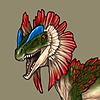HOME | DD
 Hypoem87 — Hypoemtasia Bestiary - Magnorhamphus
Hypoem87 — Hypoemtasia Bestiary - Magnorhamphus

#pterosaur #speculativefiction #traditionalart #traditionaldrawing #traditionalmedia #speculativeevolution #tapejarid #speculativezoology #hypoem87 #hypoemtasia
Published: 2020-08-04 01:08:41 +0000 UTC; Views: 5725; Favourites: 187; Downloads: 11
Redirect to original
Description
In RL and the world of Hypoemtasia, the pterosaurs are generally well-known for their bauplan which provides them the capability for powered flight. However, some genera from the order took an alternate route in the path of evolution by discarding the ability of powered flight, instead they opted for a more energy-conserving lifestyle: life on the ground. In accordance to the changes with their bauplan and their new lifestyle, many have taken the route of taking whatever is available around them and incorporate into their diet. Most tapejarids have stayed at the route of still being fruigivores, with a few number of genera either going the route of becoming omnivores or carnivores.Reaching at a height of between 30 to 60 centimeters tall and weighing around 10 to 30 kilograms, the Magnorhamphus are a genus of tapejarids that makes the islands between Shan-Gri-La and Austrotasia their home. They can be seen throughout all parts of the island. Similar to the Cursodactylus that have taken the niche of the sauropods (or the giraffes of RL), the Magnorhamphus have taken a niche of the pachycephalosaurs (not dissimilar to the hogs of RL). Indiscriminate omnivores, the tapejarids often forage for whatever they come across with on the forest floor, be it fruits or low-ground vegetation, smaller reptiles and insects, sometimes even the eggs of other pterosaurs and bones if opportunate enough. They use their large but hollow beak to communicate by clapping their beaks, accompanied by a series of caws, gruffs or drums. Males and females are virtually indistinguishable from one another, save for the presence of a pair of stripes starting around the eyes going down to the base of their lower jaw and mohawk-like bristles that are only present in the male tapejarids.
Social animals, the tapejarids often forage in a herd numbering between 4 to 7, sometimes with certain herds even reaching around 9 strong. The majority of the herd consists of juveniles led by their mother; whereas adult males are solitary for most of the time, with exception of the breeding season between November to February. That is when the males and the females come together and engage in a courtship with one another. Males will engage in a beak-clapping contest, the louder and more frequent the clap is, the higher the chance is to attract the attention of a female. After copulation, the male will accompany the female for a few months and help build and guard their nest up to 6 weeks before the pterosaur hatchlings hatch out. By then, the female will have to take care of their offspring as the male departs from her and returns to his life as a solitary amimal. The hatchlings will stay with their mother for food and safety up to 8 to 10 months before departing from her and sticking together.
Due to their solid build thanks to their powerful muscles coupled with the peculiar shape of their bill, the Magnorhampus are often preyed upon by the humans. Despite their build, the Magnorhampus are surprisingly agile and fast enough to evade predators thanks to their good sense of smell. Not only that, their large bill provides them a form of protection against said predators, as they are capable of crippling their would-be predators by clamping their jaws hard enough and leave deep bites capable of cutting tendons with the aid of their powerful jaw muscles. As such, they will take the precautions needed if they are to hunt the giant-billed tapejarids. In the modern world however, said pterosaurs are usually left alone by the humans due to the emergence of supermarkets which provides them an easy access to a huge variety of food without putting themselves at risk. Regardless, the humans will still hunt them once in a while as a form of remembrance and respect for their tribes.
--------------------------------------------------------------------------------------------------------------------------------------------------------------------------------------------------------------------------------------------------------------------------------
Inspired by the wild boars and the Kloon from Dougal Dixon's The New Dinosaurs; based on the idea that pterosaurs may take the niche most modern animals occupied and diversifying into a variety of shapes and sizes.
Plus, credits to Lediblock2 (www.deviantart.com/lediblock2 ) for providing me the idea of a tapejarid with beaks developed to crush bones!
More GUUD stuff to come soon BOIz and GURLz!
Hold on to your butts and stay safe!
Related content
Comments: 13

👍: 0 ⏩: 0

👍: 0 ⏩: 1

👍: 0 ⏩: 0

👍: 2 ⏩: 1

👍: 0 ⏩: 1

👍: 1 ⏩: 1

👍: 0 ⏩: 1

👍: 0 ⏩: 0

👍: 1 ⏩: 1


















